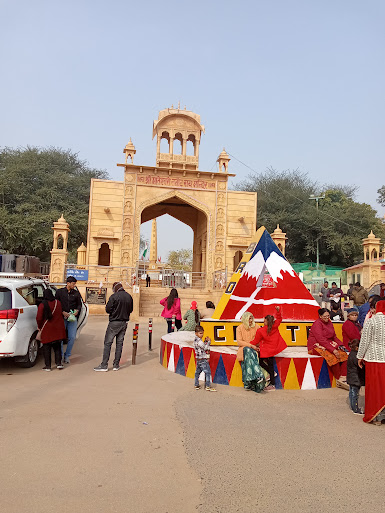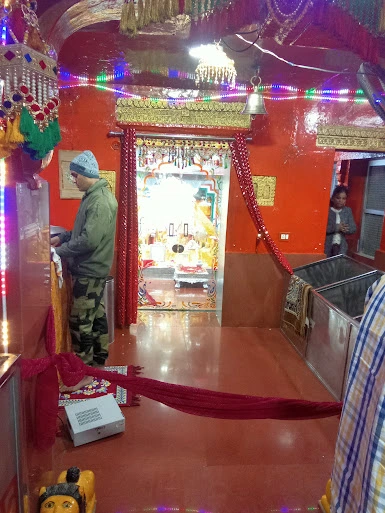The Tanot Mata Mandir is located close to the border between India and Pakistan, tucked away in the vast, peaceful Thar Desert. This hallowed shrine, honoring the goddess Tanot Mata, is a symbol of both historical bravery and profound spiritual importance. Journeying to this desert gem from Jaipur offers visitors an exciting excursion full of intriguing locations and breathtaking scenery.

Entrance Gate of Tanot Mata Mandir
How to Reach Tanot Mata Mandir from Jaipur
By Road:
The distance from Jaipur to Tanot Mata Mandir is approximately 600 kilometers. Here’s a suggested route:
- Jaipur to Jodhpur (330 km): Start your journey early to cover the first leg, which takes about 5-6 hours. Jodhpur, known as the “Blue City,” is an excellent place for a short stop.
- Jodhpur to Jaisalmer (285 km): Continue your journey towards Jaisalmer, a drive of around 5-6 hours. Jaisalmer, the “Golden City,” is a popular tourist destination with its magnificent fort and vibrant bazaars.
- Jaisalmer to Tanot Mata Mandir (120 km): The final stretch to Tanot Mata Mandir takes around 2-3 hours. This leg of the journey offers a mesmerizing drive through the Thar Desert.
By Train:
- Jaipur to Jaisalmer: Several trains connect Jaipur to Jaisalmer, including the popular Jaisalmer Express. The train journey takes around 12-13 hours.
- Jaisalmer to Tanot Mata Mandir: From Jaisalmer, hire a taxi or take a local bus to Tanot Mata Mandir. The road journey from Jaisalmer to Tanot takes about 2-3 hours.
By Air:
- Jaipur to Jaisalmer: The quickest way is to take a direct flight from Jaipur to Jaisalmer, which takes around 1.5 hours.
- Jaisalmer to Tanot Mata Mandir: From Jaisalmer airport, you can hire a taxi to reach Tanot Mata Mandir.
En Route Destinations for Tourism
1. Jodhpur:
- Mehrangarh Fort: One of the largest forts in India, offering stunning views of the city and a rich history.
- Umaid Bhawan Palace: A splendid palace that is part museum, part hotel, and part royal residence.
- Jaswant Thada: A beautiful marble cenotaph and garden built in memory of Maharaja Jaswant Singh II.
2. Jaisalmer:
- Jaisalmer Fort: A UNESCO World Heritage site, this living fort is home to shops, hotels, and ancient havelis.
- Patwon Ki Haveli: A complex of five havelis with intricate architecture and historical artifacts.
- Sam Sand Dunes: Experience the thrill of desert safaris, camel rides, and cultural performances.
3. En Route from Jaisalmer to Tanot Mata Mandir:
- Kuldhara Village: An abandoned village with a mysterious history, now a heritage site managed by the Archaeological Survey of India.
- Longewala War Memorial: A poignant reminder of the 1971 Indo-Pakistan War, offering a glimpse into the bravery of Indian soldiers.
What to Expect at Tanot Mata Mandir
Upon reaching Tanot Mata Mandir, you’ll find a tranquil and spiritually uplifting environment. The temple is maintained by the Border Security Force (BSF), and their presence adds a unique sense of security and discipline to the atmosphere. The temple complex is simple yet serene, and the deity of Tanot Mata is beautifully adorned, reflecting the deep devotion of the worshippers.
This temple, dedicated to Tanot Mata, an incarnation of the divine Hinglaj Mata, has become a symbol of miraculous survival and divine intervention during times of war. The stories of the Indo-Pakistani wars of 1965 and 1971 are particularly noteworthy, as they have cemented the temple’s reputation as a sanctuary of protection and resilience.
The 1965 Indo-Pakistan War
During the Indo-Pakistani War of 1965, the Tanot Mata Mandir witnessed a series of miraculous events that elevated it from a local place of worship to a national symbol of divine protection.
- The Battle of Tanot: The area around Tanot became a focal point during the war due to its strategic location. Pakistani forces launched an intense attack on this region, aiming to capture it. Heavy shelling and bombardment ensued, with numerous bombs being dropped around the temple complex.
- Miracle of Unexploded Bombs: Despite the relentless assault, an extraordinary phenomenon occurred: none of the bombs that landed near the temple exploded. This miraculous event is attributed to the divine intervention of Tanot Mata by the local devotees and soldiers alike. The unexploded bombs, now displayed in the temple’s museum, stand as a testament to this incredible occurrence.
- Aftermath: The survival of the temple against overwhelming odds significantly boosted the morale of the Indian soldiers. The Border Security Force (BSF) took over the maintenance of the temple after the war, further intertwining the shrine with the valor and dedication of the Indian armed forces.

BSF Soldier praying to Mata
The 1971 Indo-Pakistan War
The temple’s aura of divine protection continued into the Indo-Pakistan War of 1971, where it again played a pivotal role:
- The Battle of Longewala: Tanot Mata Mandir is located near Longewala, the site of one of the most significant battles of the 1971 war. A small contingent of Indian soldiers, numbering around 120, held off a much larger Pakistani force of over 2,000 troops with tanks. Despite being heavily outnumbered, the Indian soldiers, guided by their faith in Tanot Mata, managed to defend their post until reinforcements arrived.
- Divine Protection: Many soldiers attributed their incredible defense and survival to the blessings of Tanot Mata. The temple remained untouched throughout the conflict, reinforcing its reputation as a site of miraculous protection.
- War Memorials: Today, the area around Tanot Mata Mandir and Longewala Post is dotted with war memorials and museums. These sites commemorate the bravery and sacrifice of the Indian soldiers, and the divine legends associated with the temple add a spiritual dimension to these memorials.
The Legacy of Tanot Mata Mandir
The stories of the 1965 and 1971 wars have made Tanot Mata Mandir a place of pilgrimage for devotees and a site of reverence for the Indian armed forces. The temple’s museum, which houses the unexploded bombs and other war relics, serves as a powerful reminder of the miracles attributed to Tanot Mata and the courage of the soldiers who defended the nation.
The temple’s management by the BSF ensures that it remains well-maintained and accessible to visitors, further promoting its legacy of resilience and divine protection. The annual fairs and regular prayers conducted by the BSF personnel create a unique blend of spirituality and patriotism, making Tanot Mata Mandir a unique and deeply revered site in India’s cultural and historical landscape.
Conclusion
The journey from Jaipur to Tanot Mata Mandir is not just a physical traverse but a soulful exploration of Rajasthan’s rich cultural and historical landscape. From the architectural marvels of Jodhpur and Jaisalmer to the serene and sacred grounds of Tanot Mata Mandir, every step of the way offers something unique and enriching. As you travel through the heart of the Thar Desert, you’ll find yourself immersed in stories of valor, faith, and the timeless beauty of the Indian heritage.
If you are interested in exploring the Maa Durga Mandir in Satnali’s village, Jarwa, you can follow the provided link for more information. Discover the cultural and spiritual richness of this sacred site as you delve into the divine aura of Maa Durga’s temple.

Nice tour